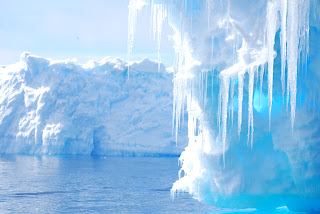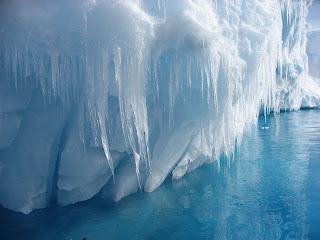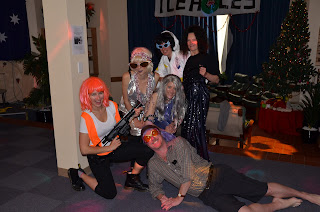Again I have to apologise for the tardiness in applying myself to adding posts to this blog. Time does seem to go so slowly down here, which makes other activities and tasks to become more laborious or even forgotten.
Anyhow here is the next submission.
Due to the re-supply being conducted over a long period of time it pushed our Christmas Day back later than the official day, which in turn led us to have our Christmas and New Years Eve (NYE) party on consecutive days.
For me NYE consisted of an iceberg cruise. There had been other cruises leading up to this particular day, however the evening I managed to get out amongst the large slabs of ice was a perfect evening. Very little wind or swell allowed for fabulous opportunities to take impressive photographs of the many icebergs, which are grounded or just floating past the station on the Antarctic currents.
 |
| Zodiac passing between icebergs |
Three zodiacs departed the wharf and headed out to where the icebergs were waiting for further 'kodak poisoning'. Trips such as these you just cannot not take so many pictures because there are so many opportunities to take a beautiful shot of an iceberg
On the boat I was travelling in, one of the guys had a waterproof camera which he had attached to a pole and was filming what was below us. I don’t have a copy of those images yet, however I do hope to obtain them and will hopefully get around to posting them on this blog.
 |
| Such colours! |
 |
| Large icicles having hanging from an iceberg |
Though in saying that, the images I have posted here are quite impressive as I am sure most of you will agree. The colours are breathtakingly beautiful and it does seem surreal to be travelling between the icebergs seeing all the different patterns in the ice and the many varying colours of blue and white.
 |
| Scoured Iceberg |
An iceberg is defined as a large piece of ice from freshwater that has broken off from a snow-formed glacier or ice shelf and is now floating in open water. Alternatively it may come to rest on the seabed in shallower water.
 |
| Aerial picture of an iceberg |
Typically only one ninth of the volume of an iceberg is above water. The shape of the underwater portion can be difficult to judge by looking at the portion above the surface. This has led to the expression ‘
tip of the iceberg’, for a problem or difficulty that is only a small manifestation of a larger problem.
 |
| Patterned iceberg |
 |
| Honeycombed iceberg |
 |
| Halo surrounding the sun with tip of an iceberg in the foreground |
Though usually confined by winds and currents to move close to the coast, the largest icebergs recorded have been
calved, or broken off, from the
Ross Ice Shelf here in Antarctica.
Iceberg B-15, photographed by satellite in 2000, measured 295 by 37 kilometres with a surface area of 11,000 square kilometres! The mass was estimated around three billion tonnes.
 |
| Note the iceberg below the surface of the water |
 |
| Icicles dripping from off of the iceberg |
 |
| Always good not to get too close in case is rolls over |
The largest iceberg on record was an Antarctic tabular iceberg of over 31,000 square kilometres. This iceberg was larger than Belgium!
When an iceberg melts, it makes a fizzing sound called ‘Bergie Seltzer’. This sound is made when compressed air bubbles trapped in the iceberg pop. The bubbles come from air trapped in snow layers that later become glacial ice.
Overall it was another wonderful experience here at Casey. It is always good to get away from the station limits and get out on the water, especially when there are views such as these.
 |
| Nice reflection in the water |
Hope you enjoyed the pics and update - regards
























